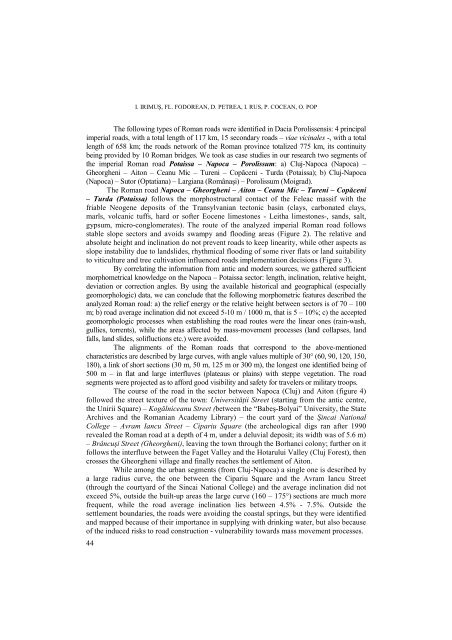geographia - Studia
geographia - Studia
geographia - Studia
You also want an ePaper? Increase the reach of your titles
YUMPU automatically turns print PDFs into web optimized ePapers that Google loves.
I. IRIMUŞ, FL. FODOREAN, D. PETREA, I. RUS, P. COCEAN, O. POP<br />
The following types of Roman roads were identified in Dacia Porolissensis: 4 principal<br />
imperial roads, with a total length of 117 km, 15 secondary roads – viae vicinales -, with a total<br />
length of 658 km; the roads network of the Roman province totalized 775 km, its continuity<br />
being provided by 10 Roman bridges. We took as case studies in our research two segments of<br />
the imperial Roman road Potaissa – Napoca – Porolissum: a) Cluj-Napoca (Napoca) –<br />
Gheorgheni – Aiton – Ceanu Mic – Tureni – Copăceni - Turda (Potaissa); b) Cluj-Napoca<br />
(Napoca) – Sutor (Optatiana) – Largiana (Românaşi) – Porolissum (Moigrad).<br />
The Roman road Napoca – Gheorgheni – Aiton – Ceanu Mic – Tureni – Copăceni<br />
– Turda (Potaissa) follows the morphostructural contact of the Feleac massif with the<br />
friable Neogene deposits of the Transylvanian tectonic basin (clays, carbonated clays,<br />
marls, volcanic tuffs, hard or softer Eocene limestones - Leitha limestones-, sands, salt,<br />
gypsum, micro-conglomerates). The route of the analyzed imperial Roman road follows<br />
stable slope sectors and avoids swampy and flooding areas (Figure 2). The relative and<br />
absolute height and inclination do not prevent roads to keep linearity, while other aspects as<br />
slope instability due to landslides, rhythmical flooding of some river flats or land suitability<br />
to viticulture and tree cultivation influenced roads implementation decisions (Figure 3).<br />
By correlating the information from antic and modern sources, we gathered sufficient<br />
morphometrical knowledge on the Napoca – Potaissa sector: length, inclination, relative height,<br />
deviation or correction angles. By using the available historical and geographical (especially<br />
geomorphologic) data, we can conclude that the following morphometric features described the<br />
analyzed Roman road: a) the relief energy or the relative height between sectors is of 70 – 100<br />
m; b) road average inclination did not exceed 5-10 m / 1000 m, that is 5 – 10%; c) the accepted<br />
geomorphologic processes when establishing the road routes were the linear ones (rain-wash,<br />
gullies, torrents), while the areas affected by mass-movement processes (land collapses, land<br />
falls, land slides, solifluctions etc.) were avoided.<br />
The alignments of the Roman roads that correspond to the above-mentioned<br />
characteristics are described by large curves, with angle values multiple of 30° (60, 90, 120, 150,<br />
180), a link of short sections (30 m, 50 m, 125 m or 300 m), the longest one identified being of<br />
500 m – in flat and large interfluves (plateaus or plains) with steppe vegetation. The road<br />
segments were projected as to afford good visibility and safety for travelers or military troops.<br />
The course of the road in the sector between Napoca (Cluj) and Aiton (figure 4)<br />
followed the street texture of the town: UniversităŃii Street (starting from the antic centre,<br />
the Unirii Square) – Kogălniceanu Street (between the “Babeş-Bolyai” University, the State<br />
Archives and the Romanian Academy Library) – the court yard of the Şincai National<br />
College – Avram Iancu Street – Cipariu Square (the archeological digs ran after 1990<br />
revealed the Roman road at a depth of 4 m, under a deluvial deposit; its width was of 5.6 m)<br />
– Brâncuşi Street (Gheorgheni), leaving the town through the Borhanci colony; further on it<br />
follows the interfluve between the Faget Valley and the Hotarului Valley (Cluj Forest), then<br />
crosses the Gheorgheni village and finally reaches the settlement of Aiton.<br />
While among the urban segments (from Cluj-Napoca) a single one is described by<br />
a large radius curve, the one between the Cipariu Square and the Avram Iancu Street<br />
(through the courtyard of the Sincai National College) and the average inclination did not<br />
exceed 5%, outside the built-up areas the large curve (160 – 175°) sections are much more<br />
frequent, while the road average inclination lies between 4.5% - 7.5%. Outside the<br />
settlement boundaries, the roads were avoiding the coastal springs, but they were identified<br />
and mapped because of their importance in supplying with drinking water, but also because<br />
of the induced risks to road construction - vulnerability towards mass movement processes.<br />
44

















